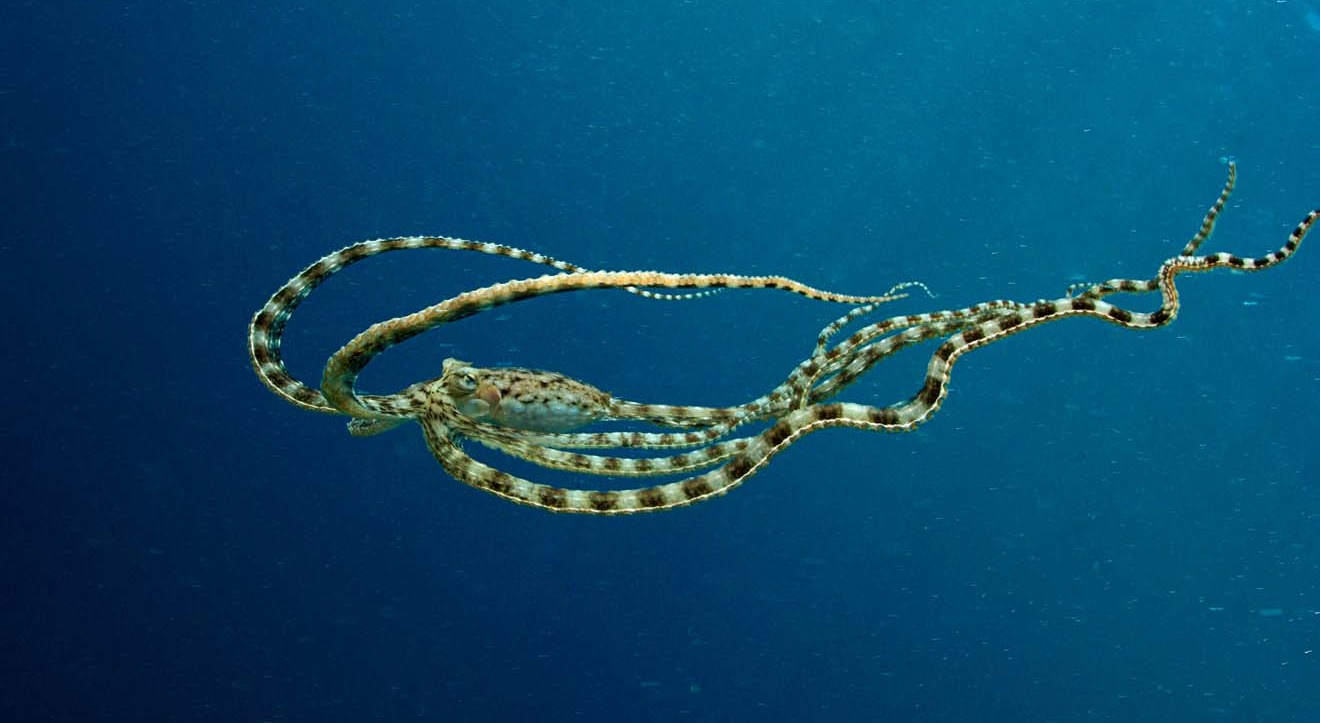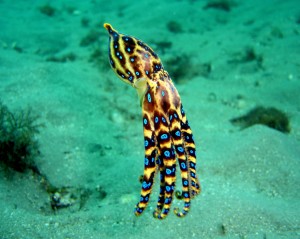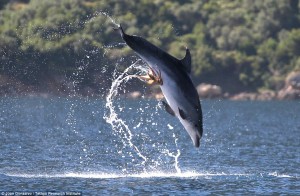How is an Octopus Smarter than a 5th Grader?
Over millions of years, species have adapted in many different ways. Octopuses in particular have evolved complex brains, allowing them to become suitable for their specific niche. They are observed as one of the most intelligent invertebrates because of their impressively large brain. A number of researchers have observed their behaviour by studying their memory capacity and learning development. A look into the evolution and the nervous system of these cephalopods could give us insight into how they could possibly be smarter than a fifth grader.
The evolution of cephalopods has been observed to evolve independently from a common bilaterian ancestor based on similarities in synapomorphies such as; triploblasty, bilateral symmetry, and cephalization (Brusca and Brusca 2003). In losing their protective shell of their ancestors, they were able to develop new skills unbounded but also unprotected. They explored caves and rocks for their new hunting grounds and to exploit this new opportunity they started to evolve more complex brains (Zimmer 2008). Being unprotected forced octopuses to have to develop and rely more on their intelligence and their ability to blend in, camouflage and mimic the environment. They are able to match colour, texture and patterns of their surrounding with accuracy and better yet, when blending in isn’t enough, they can create moving patterns on their flesh. Cephalopods have chromatophores, which are a sac of pigments controlled by the nervous fibers extended from the central brain. When the muscles flex, the sacs expand allowing the colour to become visible (Graziano et al. 2012). Each of the octopus’s eight tentacles have the ability to think by itself and to change the speed of their nerve signals (Hochner et al. 2006). It not only changes the body colour quickly, but also provides the animal with fast camouflage, signalling and communication.
 The octopus has shown to be a social learner (Biederman and Davey 1993). They are able to observe a visual discrimination test, and afterwards while demonstrating their own tests they will consistently choose the same objects from their own observations (Mitsuru Tomita and Setsuyuki Aoki 2014). Play in octopuses regardless of age is interesting since the behaviour is evidence for convergent evolution of intelligence from vertebrates (Kuba et al. 2006). They have been documented to be clever, unpredictable and possess very diverse personalities. The octopus can retain tactile memories for about 5 days by removing the vertical lobe after a task has been learned which has been shown to enhance memory retention (Hochner et al. 2006). They have short-term and long-term memory, which helps them learn and retain skills. They have the ability to solve puzzles, like mazes, learn through observation and even use tools to solve immediate problems (Hochner et al. 2006). Octopuses have even learned to attach themselves to dusky dolphins to avoid being used as a play toy (Orbach and Kitchener 2014). Dolphins will pull the octopus around and not let it escape, ignoring the octopus’ usual defensive methods such as inking. To stop this behaviour, an octopus will use its strong arms and suckers to hold onto the dolphin as it swims, ignoring the dolphins agitated behaviour.
The octopus has shown to be a social learner (Biederman and Davey 1993). They are able to observe a visual discrimination test, and afterwards while demonstrating their own tests they will consistently choose the same objects from their own observations (Mitsuru Tomita and Setsuyuki Aoki 2014). Play in octopuses regardless of age is interesting since the behaviour is evidence for convergent evolution of intelligence from vertebrates (Kuba et al. 2006). They have been documented to be clever, unpredictable and possess very diverse personalities. The octopus can retain tactile memories for about 5 days by removing the vertical lobe after a task has been learned which has been shown to enhance memory retention (Hochner et al. 2006). They have short-term and long-term memory, which helps them learn and retain skills. They have the ability to solve puzzles, like mazes, learn through observation and even use tools to solve immediate problems (Hochner et al. 2006). Octopuses have even learned to attach themselves to dusky dolphins to avoid being used as a play toy (Orbach and Kitchener 2014). Dolphins will pull the octopus around and not let it escape, ignoring the octopus’ usual defensive methods such as inking. To stop this behaviour, an octopus will use its strong arms and suckers to hold onto the dolphin as it swims, ignoring the dolphins agitated behaviour.
The nervous system of an octopus is a massive trade off. Signalling between 500 million neurons requires constant pumping of electrical charges. Taking in account the size of their brain in relation to their body size, we can see that the octopus is probably using the brain for something that makes the physical constraint advantageous (Godfrey-Smith 2013). In 1986, a correlation between different styles of foraging for food and brain size was found. Finding argue that “extractive foraging is seen in animals with larger and more complex brains” (Gibson 1986). The kind of foraging involves adapting food choices to available resources, extracting food from protective shells in a gentile and flexible manner (Gibson 1986).
While we would conclude that the large brain of an octopus is the explanation for their ‘alien-like’ intelligence, we lack sufficient information as to why these invertebrates developed such a large brain and what caused this convergent evolution to occur. The extraordinary intelligence of an octopus has inspired us to further study the evolution of their nervous system, their body function and how they live in the world today. Further research is necessary to better understand these unique creatures. Although the human brain out competes that of an octopus’, it’s ability to process information and apply it to their ecological environment is quite remarkable.
Work cited
Biederman G.B., Davey V.A. 1993. Social learning in invertebrates. Science (1627-1628)[internet]. [Cited 2016 Mar 02]. Available from http://science.sciencemag.org/content/259/5101/1627 DOI: 10.1126/science.259.5101.1627
Brusca R. C., Brusca G.J. 2003. Invertebrates 2nd ed. Sinauer associates. Sunderland, MA, USA 1-141. [internet]. [Cited 2016 Mar 02]. Available from http://sysbio.oxfordjournals.org/content/53/4/664.full
Gibson, K.R. 1986. Cognition, brain size and the extraction of embedded food resources. Primate ontogeny, cognition and social behaviour. Cambridge university press, Cambridge, 93-105.
Graziano F., Nadav S., Noam J., Piero A. 2012. Camouflaging in a complex environment octopuses use specific features of their surroundings for background matching. PLoS. [internet]. [Cited 2016 March 04]; 7(5).1-6. Available from: http://www.plosone.org/article/fetchObject.action?uri=info:doi/10.1371/journal.pone.007579&representation=PDF
DOI: 10.1371/journal.pone.0037579
Godfrey-Smith, P. 2013. Cephalopods and the evolution of the mind. Pac conserv Biol. 19; 4-9. [internet]. [Cited 2016 Mar 02]. Available from http://petergodfreysmith.com/wp-content/uploads/2013/06/Cephalopods_PGS_PacCon_2013Final.pdf
Hochner B., Shomat T., Fiorito G. 2006. The octopus: a model for a comparative analysis of the evolution and memory mechanisms. Biol Bull. [internet]. [Cited 2016 March 04]; 210: 308-317. Available from http://www.biolbull.org/content/210/3/308.full.pdf+html
Kuba M.J., Byrne R.A., Mather J.A., Meisel D.V. 2006. When do octopuses play? Effects of repeated testing, object type, age, and food deprivation on object play in octopus vulgaris. J Comp Psychol. [internet]. [Cited 2016 Mar 02]; 120(3): 184-190. Available from http://homepages.gac.edu/~jwotton2/PSY225/oct.pdf
Orbach, D.N., Kitchener T. 2014. Armed escorts: Dusky dolphin’s interactions with octopuses in New Zealand. Aquat Mamm. [Internet]. [Cited March 6, 2016.] 40(3): 285-292. Available from http://eds.a.ebscohost.com/eds/pdfviewer/pdfviewer?sid=85a66940-b32c-482e-b68c-07f593213663%40sessionmgr4004&vid=8&hid=4113
DOI: 10.1578/AM.40.3.2014.285
Tomita M., Aoki S. 2014. Visual discrimination learning in the small octopus Octopus ocellatus. [cited March 8, 2016] retrieved from: http://eds.b.ebscohost.com/eds/pdfviewer/pdfviewer?sid=a3047f50-e9ac-4313-836d-c6e9b2dacf89%40sessionmgr111&vid=4&hid=119
Zimmer C. 2008. How smart are octopuses? New York Times. [internet]. [Cited 2016 Mar 02]. Available from http://www.slate.com/articles/health_and_science/science/2008/06/how_smart_is_the_octopus.html
Click on images for reference*





